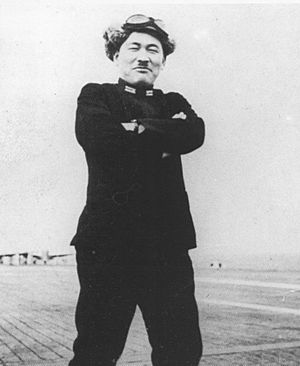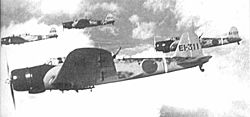Shigekazu Shimazaki facts for kids
Quick facts for kids
Shigekazu Shimazaki
|
|
|---|---|

Shigekazu Shimazaki aboard the carrier Zuikaku at an unknown date.
|
|
| Born | September 9, 1908 Ōita, Japan |
| Died | January 9, 1945 (aged 36) near Taiwan (†KIA) |
| Allegiance | |
| Service/ |
|
| Years of service | 1929-1945 |
| Rank | |
| Commands held | Wing Leader Zuikaku Senior Air Officer 752nd Kōkūtai (based in Taiwan) Senior Air Officer Nagoya Kōkūtai Staff officer 2nd Air Fleet Staff officer 3rd Air Fleet |
| Battles/wars | World War II (Attack on Pearl Harbor, Indian Ocean raid, Battle of the Coral Sea, Aerial Battle of Taiwan-Okinawa) |

Shigekazu Shimazaki (嶋崎 重和, September 9, 1908 – January 9, 1945) was a Japanese officer and pilot. He served in the Imperial Japanese Navy Air Service during World War II. He is famous for leading a key part of the attack on Pearl Harbor.
Contents
Biography
Early Life and Training
Shigekazu Shimazaki was born in Ōita Prefecture, Japan. He joined the Imperial Japanese Navy Academy in 1929. He was a good student, graduating 31st in his class. After serving on cruisers, he became a pilot in 1932. By 1934, he was teaching other pilots how to fly torpedo bombers.
Starting His Combat Career
From 1935 to 1937, Shimazaki worked on the aircraft carrier Kaga. He also taught on the ground. When the Second Sino Japanese War began in 1937, he was sent to a base in Shanghai. There, he flew many bombing missions as the war got bigger. He then served on the carrier Sōryū before returning to teaching. In 1939, he went back to combat on the carrier Akagi. He was promoted to lieutenant commander in November 1940.
Leading the Pearl Harbor Attack
In September 1941, Shimazaki helped prepare the new carrier Zuikaku. He became the commander of its air wing. He is best known for leading the second wave of planes in the attack on Pearl Harbor. This happened on December 7, 1941. He flew a Nakajima B5N2 "Kate" bomber. He led 54 high-level bombers and 78 dive bombers.
After this successful attack, he and Mitsuo Fuchida met with Emperor Shōwa in Tokyo. This was a great honor.
Battles in the Indian Ocean and Coral Sea
Four months later, Shimazaki was still on the Zuikaku. He took part in a raid on Trinkomalee on April 9, 1942. This was a British port in Ceylon. He led 18 "Kates" to bomb the port.
A month later, Shimazaki fought in the Battle of the Coral Sea. On May 7, 1942, his group searched for US aircraft carriers. They found the oiler USS Neosho and its escort destroyer USS Sims instead. Shimazaki's planes did not attack these smaller ships. Later that night, he tried a night attack on US carriers. His group lost many planes, but he survived.
The next day, May 8, 1942, Shimazaki led his "Kates" to attack USS Lexington. They badly damaged the carrier, which later sank. However, his own plane was hit hard. He had to ditch his plane in the ocean but was rescued.
Later Career and Death
In July 1942, Shimazaki was moved to a ground base. He spent the rest of his career as an air officer on land. He was promoted to commander in October 1944.
Shimazaki was killed in action in January 1945. This happened near Taiwan. He was serving as a staff officer for the IJN 3rd Air Fleet. After his death, he was promoted two ranks to rear admiral.
See also
 In Spanish: Shimazaki Shigekazu para niños
In Spanish: Shimazaki Shigekazu para niños

